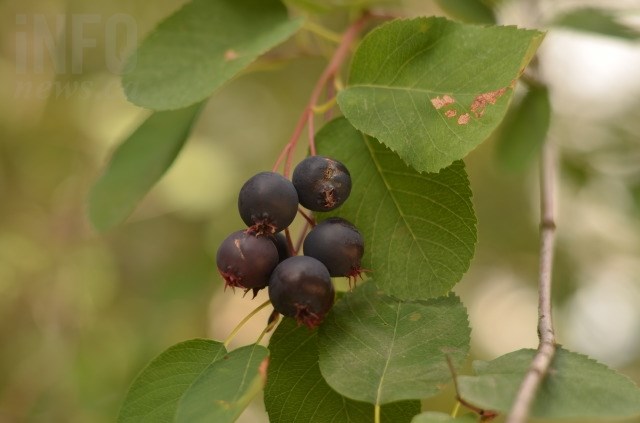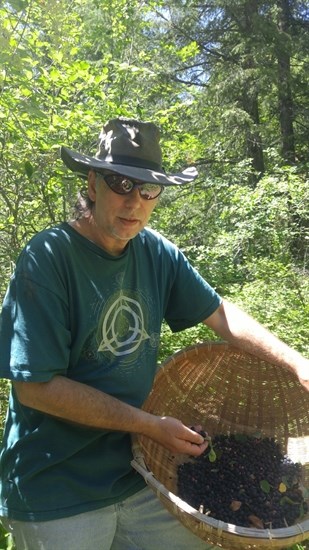
Saskatoon berries
(CHARLOTTE HELSTON - REPORTER / iNFOnews.ca)
July 12, 2018 - 6:30 PM
If you’ve been wondering why so many people are parked on the side of the road with buckets in hand, the answer is a bumper crop of wild Saskatoon berries.
Ordinarily dry, shrivelled up, and not all that appetizing, this year’s Saskatoons are plump, juicy and delicious, prompting large crowds to roadside ditches where the bushes are laden with berries, Don Elzer of Lumby's Wildcraft Forest School says.
“It’s been an incredible year with all this moisture we’ve had,” Elzer says.
The problem with Saskatoons is that usually when the fruit ripens around early August or late July, there’s not enough moisture to keep them juicy and they dry up in a matter of days.
“So the harvest is kind of missed unless you’re on top of it,” he says.
This year, however, rainfall has kept the berries tender, juicy and tasty — not to mention bigger and more abundant.
With a taste and appearance similar to a blueberry, Elzer says they are used in jams, pies, and even wines and liqueurs. An excellent source of anti-oxidants, you can also dry them or put them in the freezer.
Popular in the Prairies, Saskatoons are also known as June berries and serviceberries (nope, not a typo) in other regions where they grow, he says. The berry has long been used by indigenous peoples and is known in the Secwepemc language as speqpeq7u’w’i.

Image Credit: Contribited/ Don Elzer
The berries are also favoured by birds and bears.
“The primary competition we have for Saskatoons in the wild are bears,” Elzer says.
He says bears will put whole branches into their mouths and essentially scrape their way down, taking in twigs and leaves along with the berries. The neat thing about that, Elzer says, is that in the process they also prune the tree.
“Now there aren’t so many bears so the Saskatoons grow very high and spindly, and as a result, they become unhealthy,” he says. “The bears have been doing us a favour creating these healthy Saskatoon berries.”
Elzer says it’s been encouraging to see so many people this year out picking wild Saskatoon berries.
“Wherever I go I find all kinds of people parked on the side of the road picking these berries, and that’s surprised me. I thought maybe those days had gone past us and maybe there wasn’t the same kind of interest there used to be, but I think this year is proving me wrong. Maybe because the Saskatoons are so abundant, people just can't resist,” he says.
In the same breath, Elzer says it’s also important to harvest wisely. Leave some for the bears and songbirds, and if there are multiple bushes, pick from the ones closest to the road and leave the rest for wildlife.
“Give the wildlife a chance to be more private while they consume the berries,” Elzer says.
He also suggests propagating your own Saskatoon bushes. You can transplant suckers that grow near the bushes, or grow them from seed. With a little water, he says they make great backyard berry bushes.
“With development and agriculture, a lot of these trees and shrubs, their populations plummet. It’s up to us to create recovery plants in our own backyards,” he says.
With this year’s incredible wild crop, he says many people are likely going out and picking Saskatoons for the first time.
“Now they’re aware of these berries and in following years they’ll keep their eyes open. So the positive side of it, on the food side, is we’re re-wilding our diet when we start to include native species from the natural world into our food supply. We’re out in nature, pulling ourselves away from computers and devices and enjoying the outdoors. And it’s good exercise.”
There’s still time to get out and pick Saskatoons, especially if you find bushes near lakes or rivers where the extra moisture keeps them extra plump.
Remember to keep an eye out for bears and be mindful that some roadside bushes may have been sprayed with herbicides.
To contact a reporter for this story, email Charlotte Helston or call 250-309-5230 or email the editor. You can also submit photos, videos or news tips to the newsroom and be entered to win a monthly prize draw.
We welcome your comments and opinions on our stories but play nice. We won't censor or delete comments unless they contain off-topic statements or links, unnecessary vulgarity, false facts, spam or obviously fake profiles. If you have any concerns about what you see in comments, email the editor in the link above.
News from © iNFOnews, 2018